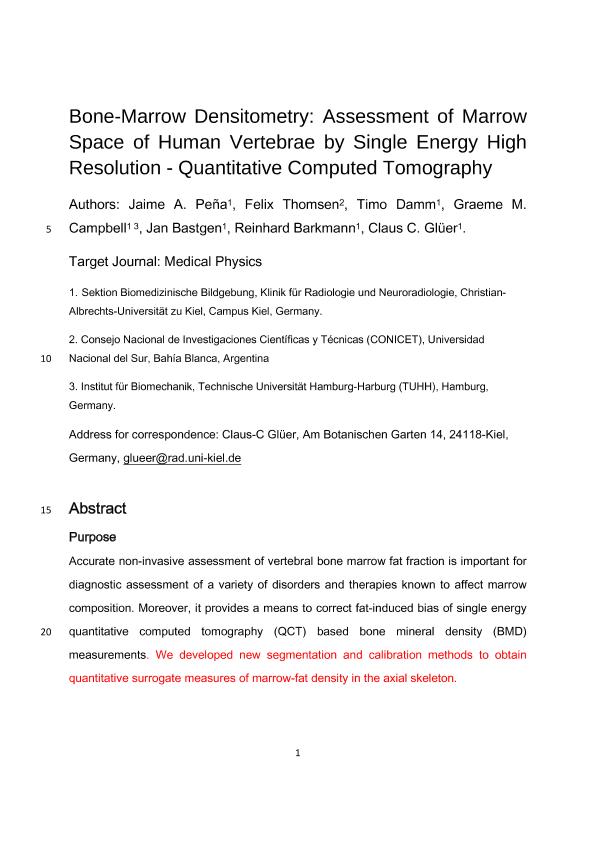Mostrar el registro sencillo del ítem
dc.contributor.author
Peña, Jaime A.
dc.contributor.author
Thomsen, Felix Sebastian Leo

dc.contributor.author
Damm, Timo
dc.contributor.author
Campbell, Graeme M.
dc.contributor.author
Bastgen, Jan
dc.contributor.author
Barkmann, Reinhard
dc.contributor.author
Glüer, Claus C.
dc.date.available
2018-06-22T17:34:51Z
dc.date.issued
2016-07
dc.identifier.citation
Peña, Jaime A.; Thomsen, Felix Sebastian Leo; Damm, Timo; Campbell, Graeme M.; Bastgen, Jan; et al.; Bone-marrow densitometry: Assessment of marrow space of human vertebrae by single energy high resolution-quantitative computed tomography; American Association of Physicists in Medicine; Medical Physics; 43; 7; 7-2016; 4174-4183
dc.identifier.issn
0094-2405
dc.identifier.uri
http://hdl.handle.net/11336/49665
dc.description.abstract
Purpose: Accurate noninvasive assessment of vertebral bone marrow fat fraction is important for diagnostic assessment of a variety of disorders and therapies known to affect marrow composition. Moreover, it provides a means to correct fat‐induced bias of single energy quantitative computed tomography (QCT) based bone mineral density (BMD) measurements. The authors developed new segmentation and calibration methods to obtain quantitative surrogate measures of marrow‐fat density in the axial skeleton. Methods: The authors developed and tested two high resolution‐QCT (HR‐QCT) based methods which permit segmentation of bone voids in between trabeculae hypothesizing that they are representative of bone marrow space. The methods permit calculation of marrow content in units of mineral equivalent marrow density (MeMD). The first method is based on global thresholding and peeling (GTP) to define a volume of interest away from the transition between trabecular bone and marrow. The second method, morphological filtering (MF), uses spherical elements of different radii (0.1–1.2 mm) and automatically places them in between trabeculae to identify regions with large trabecular interspace, the bone‐void space. To determine their performance, data were compared ex vivo to high‐resolution peripheral CT (HR‐pQCT) images as the gold‐standard. The performance of the methods was tested on a set of excised human vertebrae with intact bone marrow tissue representative of an elderly population with low BMD. Results: 86% (GTP) and 87% (MF) of the voxels identified as true marrow space on HR‐pQCT images were correctly identified on HR‐QCT images and thus these volumes of interest can be considered to be representative of true marrow space. Within this volume, MeMD was estimated with residual errors of 4.8 mg/cm3 corresponding to accuracy errors in fat fraction on the order of 5% both for GTP and MF methods. Conclusions: The GTP and MF methods on HR‐QCT images permit noninvasive localization and densitometric assessment of marrow fat with residual accuracy errors sufficient to study disorders and therapies known to affect bone marrow composition. Additionally, the methods can be used to correct BMD for fat induced bias. Application and testing in vivo and in longitudinal studies are warranted to determine the clinical performance and value of these methods.
dc.format
application/pdf
dc.language.iso
eng
dc.publisher
American Association of Physicists in Medicine

dc.rights
info:eu-repo/semantics/openAccess
dc.rights.uri
https://creativecommons.org/licenses/by-nc-sa/2.5/ar/
dc.subject
Bone Densitometry
dc.subject
Bone Marrow
dc.subject
Computed Tomography
dc.subject
Image Analysis
dc.subject
Marrow Fat
dc.subject.classification
Medicina Critica y de Emergencia

dc.subject.classification
Medicina Clínica

dc.subject.classification
CIENCIAS MÉDICAS Y DE LA SALUD

dc.title
Bone-marrow densitometry: Assessment of marrow space of human vertebrae by single energy high resolution-quantitative computed tomography
dc.type
info:eu-repo/semantics/article
dc.type
info:ar-repo/semantics/artículo
dc.type
info:eu-repo/semantics/publishedVersion
dc.date.updated
2018-06-07T16:12:27Z
dc.journal.volume
43
dc.journal.number
7
dc.journal.pagination
4174-4183
dc.journal.pais
Estados Unidos

dc.journal.ciudad
Nueva York
dc.description.fil
Fil: Peña, Jaime A.. Christian‐Albrechts‐Universität zu Kiel; Alemania
dc.description.fil
Fil: Thomsen, Felix Sebastian Leo. Consejo Nacional de Investigaciones Científicas y Técnicas. Centro Científico Tecnológico Conicet - Bahía Blanca; Argentina. Universidad Nacional del Sur; Argentina
dc.description.fil
Fil: Damm, Timo. Christian‐Albrechts‐Universität zu Kiel; Alemania
dc.description.fil
Fil: Campbell, Graeme M.. Christian‐Albrechts‐Universität zu Kiel; Alemania. Technische Universität Hamburg‐Harburg; Alemania
dc.description.fil
Fil: Bastgen, Jan. Christian‐Albrechts‐Universität zu Kiel; Alemania
dc.description.fil
Fil: Barkmann, Reinhard. Christian‐Albrechts‐Universität zu Kiel; Alemania
dc.description.fil
Fil: Glüer, Claus C.. Christian‐Albrechts‐Universität zu Kiel; Alemania
dc.journal.title
Medical Physics

dc.relation.alternativeid
info:eu-repo/semantics/altIdentifier/url/https://aapm.onlinelibrary.wiley.com/doi/abs/10.1118/1.4950874
dc.relation.alternativeid
info:eu-repo/semantics/altIdentifier/doi/http://dx.doi.org/10.1118/1.4950874
Archivos asociados
